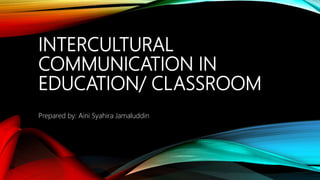
Intercultural communication in Education/ classroom
- 1. INTERCULTURAL COMMUNICATION IN EDUCATION/ CLASSROOM Prepared by: Aini Syahira Jamaluddin
- 2. DEFINITION OF INTERCULTURAL COMMUNICATION • Samovar et al. (1998) ‘communication between people whose cultural perceptions and symbol systems are distinct enough to alter the communication event’ (p. 48) • Chen and Starosta (1998) ‘the communication between people from two different cultures’ (p. 28) • There is a process where people more closely identify with each other, through global branding, shared media, and the possibility of gaining knowledge about one another (Rosengren, 2004). • Two persons from diverse linguistic and cultural background make negotiations and understanding of meaning in human experiences across social systems and societies (Anuar, 2017)
- 3. WHY LEARN INTERCULTURAL COMMUNICATION? Decreasing misunderstanding (Chen and Starosta, 1998), tolerating cultural diversity (Gudykunst and Kim, 1984), and developing adaptive culture (Dodd, 1991). A need for more effective communication in institutions (schools, hospitals, offices etc.) Scientific approaches can help us understand how cultural diversity can affect the efficiency of communication.
- 4. MALAYSIAN (Department of Statistics Malaysia, updated in 2011)
- 5. RESEARCH DONE • An Intercultural Study of Refusal Strategies in English between Jordanian EFL and Malay ESL Postgraduate Student by Yasser, Marlyna and Subakir in 2012. • English Language Learning Strategies of Malaysian Secondary School Students: Implication for Inter-Cultural Communication by Zainab and Mallam in 2014. • A Study on the Level of Intercultural Knowledge among Malaysian Secondary School Students by Fatin and Manjet in 2016. • Cultural Differences in Communication Between Native and Non-Native ESL Teachers by Norhezrin in 2017. • Intercultural communication in the Malaysian Vision Schools: Implications for the management and leadership in a multicultural primary school by azam Othman, 2016 • Multiculturalism in Higher Education: A Case Study of Middle Eastern Students’ Perceptions and Experiences in a Malaysian University by Ambigapathy in 2008.
- 6. 1) CULTURAL DIFFERENCES IN COMMUNICATION BETWEEN NATIVE AND NON- NATIVE ESL TEACHERS BY NORHEZRIN ANUAR IN 2017 • Focus on American English native speakers and Malay non-native speakers who are ESL teachers. Ways Used to Solve Misunderstanding: Ting-Toomey’s (1999) Constructive Intercultural Conflict Management Skills framework Collaborative Dialogue -throwing candies incident A: I'm not telling you not to do it. But it's not something we would do. B: If it's worth saying it to me, it's worth for me listening. Face-Management Skill Jokes are one of the strategies that could be used in saving one’s ‘face’. Mindful reframing interpret each other based from the other’s point of view. Communication Adaptability adapt to the needs of the particular situation
- 7. 2) INTERCULTURAL COMMUNICATION IN THE MALAYSIAN VISION SCHOOLS: IMPLICATIONS FOR THE MANAGEMENT AND LEADERSHIP IN A MULTICULTURAL PRIMARY SCHOOL BY AZAM OTHMAN, 2016 Generally, students gave rather negative feedback on some aspects of the Vision Schools. About 58 percent of the respondents disagreed that the Vision Schools offer programs that develop national integration, the children reported that their perception towards the other races is very much influenced by their social interaction with them. Young children in the Vision Schools that they understood the meaning of tolerance and unity, and they reported the relationships with other races were Their intercultural experiences seemed be positive in a number of aspects such as their relationships with other people, the absence of racism in school, and the lack of negative experiences involving harsh racist But at the same time, there are aspects of intercultural experiences that they think are lacking, such as playing sports with other races, having meals with peers from different races, and learning the various spoken languages in the school compound.
- 8. 3) MULTICULTURALISM IN HIGHER EDUCATION: A CASE STUDY OF MIDDLE EASTERN STUDENTS' PERCEPTIONS AND EXPERIENCES IN A MALAYSIAN UNIVERSITY BY AMBIGAPATHY PANDIAN, 2008 • It was shown that only certain circumstances involved notions of perceived discrimination, prejudice, tolerance and stereotyping but these encounters were infrequent. • Peer-pairing programmes (after class activities) • Inter-cultural cooperative learning strategies - inter- cultural group work decreases stereotypes and increases the motivation and willingness of students to work with members of other groups. • Residential programmes - integrate intercultural activities across a range involving inter-cultural activities in all aspects of student life
- 9. 4) RELATIONSHIP BETWEEN STUDENTS ADJUSTMENT FACTORS AND CROSS CULTURAL ADJUSTMENT: A SURVEY AT THE NORTHERN UNIVERSITY OF MALAYSIA BY CHE SU MUSTAFFA & MUNIRAH ILIAS, 2013 • The correlations between the cross-cultural adjustments with Academic Factor, Socio-Cultural Factor, Personal-Emotion Factor, Environment Factor and Intercultural Communication Apprehension Factor. • Most of Master’s and PhD students easily adjust compared to the undergraduate students. This might be because these students already had prior experiences traveling abroad before they came to UUM. students who had previously spent between three and twelve months abroad felt they were better able to use facilities of communication and were more aware of themselves and culture. • Language proficiency influences the adjustment process among the international students at UUM. the majority of the respondents are well adjusted with their academic system, academic environment and academic teaching style that are applied at UUM.
Notas do Editor
- According to the Ministry of Education (2000), Vision School is a primary school complex in which two or three schools of different types (national, Chinese, and Tamil national-type schools) are placed together. government’s strategies to enhance national integration among students in Malaysia. According to principals from different Vision Schools, sharing common facilities will provide the space and opportunity for different ethnic groups to interact with each other. The aims of Vision Schools are to promote integration among children of different ethnic groups and to enhance understanding, cooperation, and tolerance among them
